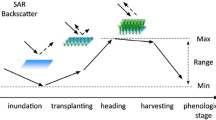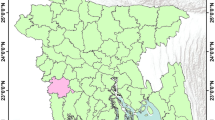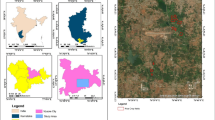Abstract
In India, agriculture monitoring is severely hampered by frequent cloud cover. Crop health assessment from the early growing stage onwards is vital for accurate and timely yield prediction. In this study, time series of Sentinel-1A SAR images over central India have been processed to quantify kharif crops’ growth rate. Sentinel-1 and Sentinel-2 images acquired on the same day have been used to compare the radar backscattered energy at the VH channel with normalized difference vegetation index (NDVI). A good coefficient of determination (R2 = 0.824) was found between backscatter and NDVI. It attests that the NDVI can be used in combination with SAR backscatter during the kharif season. In addition, k-means clustering classification of Sentinel-1 images indicated that the total area covered by paddy, soybean, and other crops were 103,506.86 ha, 85,390.93 ha, and 71,667.02 ha, respectively. The classification result has been validated with ground information, which has indicated an overall accuracy of 83.47%. The work indicated that radar signals’ temporal behavior is sensitive to the health status of the crops from sowing to harvesting stages. Sentinel-1 SAR images can be used to analyze kharif crops during the whole phenological cycle. The approach may serve as a solution for assessing both the health and spatial distribution of kharif crops.

















Similar content being viewed by others
References
Mishra VN, Prasad R, Kumar P, Srivastava PK, Rai PK (2017) Knowledge-based decision tree approach for mapping spatial distribution of rice crop using C-band synthetic aperture radar-derived information. J Appl Remote Sens. 11(4):046003
Agriculture Today (2019) https://www.agriculturetoday.in/cover-feature/2019/oct-2019.pdf
Meng, JH, Wu, B.F (2008) Study on the crop condition monitoring methods with remote sensing. Int Arch Photogramm Remote Sens Spat Inf Sci, Vol. XXXVII. Part B8: 945–950.
Robert M, Thomas A, Bergez JE (2016) Processes of adaptation in farm decision-making models. A review Agron Sustain Dev 36:64
Shirsath PB, Sehgal VK, Aggarwal PK (2020) Downscaling regional crop yields to local scale using remote sensing. Agriculture 10:58
Waldner F, Fritz S, Gregorio AD, Defourny P (2015) Mapping priorities to focus cropland mapping activities: fitness assessment of existing global, regional and national cropland maps. Remote Sens 7:7959–7986
Bastiaanssen WGM, Molden DJ, Makin IW (2000) Remote sensing for irrigated agriculture: examples from research and possible applications. Agric Water Manage 46(2):137–155
Gumma MK, Uppala D, Ahmad MI, Whitebread AM, Mohammed IR (2015) Mapping direct seeded rice in Raichur district of Karnataka. India Photogramm Eng Remote Sens 81(11):873–880
Jin C, Xiao X, Dong J, Qin Y, Wang Z (2016) Mapping paddy rice distribution using multi-temporal Landsat imagery in the Sanjiang Plain, northeast China. Front Earth Sci 10(1):49–62
Kumar P, Gupta DK, Mishra VN, Prasad R (2015) Comparison of support vector machine, artificial neural network and spectral angle mapper algorithms for crop classification using LISS IV data. Int J Remote Sens 36(6):1604–1617
Kumar P, Gupta DK, Mishra VN, Prasad R (2015) Comparison of support vector machine, artificial neural network, and spectral angle mapper algorithms for crop classification using LISS IV data. Int J Remote Sens 36(6):1604–1617
Verma A, Kumar A, Lal K (2019) Kharif crop characterization using combination of SAR and MSI optical sentinel satellite datasets. J Earth Syst Sci 128(8):230
Cong N, Wang T, Nan H, Ma Y, Wang X, Myneni RB, Piao S (2013) Changes in satellite-derived spring vegetation green-up date and its linkage to climate in China from 1982 to 2010: a multimethod analysis. Glob Change Biol 19:881–891
Hütt C, Waldhoff G (2018) Multi-data approach for crop classification using multitemporal, dual-polarimetric Terra SAR-X data, and official geodata. Eur J Remote Sens 51(1):62–74
Lasko K, Vadrevu KP, Tran VT, Justice C (2018) Mapping double and single crop paddy rice with Sentinel-1A at varying spatial scales and polarizations in Hanoi, Vietnam. IEEE J Sel Top Appl Earth Obs Remote Sens. 11(2):498–512
Ulaby FT, Robert YL, Shanmugan KS (1982) Crop classification using airborne radar and Landsat data; IEEE Trans. Geosci Remote Sens 1:42–51
Guan K, Li Z, Rao LN, Gao F, Xie D, Hien NT (2018) Mapping paddy rice area and yields over Thai Binh Province in Viet Nam from MODIS, Landsat, and ALOS-2/ PALSAR-2. IEEE J Sel Top Appl Earth Obs Remote Sens 11(7):2238–2252
Jiao X, Kovacs JM, Shang J, McNairn H, Walters D, Ma B, Geng X (2014) Object-oriented crop mapping and monitoring using multi-temporal polarimetric RADARSAT-2 data. ISPRS J Photogramm Remote Sens 96:38–46
Li H, Ce Z, Zhang S, Atkinson PM (2020) Crop classification from full-year fully-polarimetric L-band UAVSAR time-series using the Random Forest algorithm. Int J Appl Earth Obs. 87:102032
Nguyen DB, Gruber A, Wagner W (2016) Mapping rice extent and cropping scheme in the Mekong delta using Sentinel-1A data. Remote Sens Lett 7(12):1209–1218
Sicre CM, Fieuzal R, Baup F (2020) Contribution of multispectral (optical and radar) satellite images to the classification of agricultural surfaces. In J Appl Earth Obs 84:101972
Sonobe R (2019) Parcel-based crop classification using multi-temporal TerraSAR-X Dual Polarimetric Data. Remote Sens 11:1148
Zhang W, Chen E, Li Z, Zhao L, Ji Y, Zhang Y (2018) Rape (Brassica napus L) growth monitoring and mapping based on Radarsat-2 time-series data. Remote Sens. 10(2):206
Carneiro FM, Angeli Furlani CE, Zerbato C (2020) Comparison between vegetation indices for detecting spatial and temporal variabilities in soybean crop using canopy sensors. Precision Agric 21:979–1007
Ghazaryan G, Dubovyk O, Löw F, Lavreniuk M, Kolotii A, Jürgen Schellberg J, Kussul N (2018) A rule-based approach for crop identification using multi-temporal and multi-sensor phenological metrics. Eur J Remote Sens 51(1):511–524
Heupel K, Spengler D, Itzerott SA (2018) Progressive crop-type classification using multitemporal remote sensing data and phenological information. PFG-J PHOTOGRAMM REM 86:53–69
Natteshan NVS, Kumar NS (2020) Effective SAR image segmentation and classification of crop areas using MRG and CDNN techniques. Eur J Remote Sens 53(S1):126–140
Wei S, Zhang H, Wang C, Wang Y, Xu L (2019) Multi-temporal SAR data large-scale crop mapping based on U-Net model. Remote Sens 11(1):68
De Alban JDT, Connette GM, Oswald P, Webb EL (2018) Combined Landsat and L-Band SAR data improves land cover classification and change detection in dynamic tropical landscapes. Remote Sens 10:306
Mishra VN, Prasad R, Rai PK, Vishwakarma AK, Arora A (2019) Performance evaluation of textural features in improving land use/land cover classification accuracy of heterogeneous landscape using multi-sensor remote sensing data. Earth Sci Inform 12(1):71–86
Kumar P, Prasad R, Choudhary A, Gupta DK, Mishra VN, Vishwakarma AK, Singh AK, Srivastava PK (2019) Comprehensive evaluation of soil moisture retrieval models under different crop cover types using C-band synthetic aperture radar data. Geocarto Int 34(9):1022–1041
Haarpaintner J, Hindberg H (2019) Multi-temporal and multi-frequency SAR analysis for forest land cover mapping of the Mai-Ndombe District (Democratic Republic of Congo). Remote Sens 11:2999
Winsvold SH, Kääb A, Nuth C, Andreassen LM, Van Pelt WJJ, Schellenberger T (2018) Using SAR satellite data time series for regional glacier mapping. Cryosphere 12:867–890
Becker-Reshef I, Justice C, Sullivan M, Vermote E, Tucker C, Anyamba A, Small J, Pak E, Masuoka E, Schmaltz J (2010) Monitoring global croplands with coarse resolution earth observations: the Global Agriculture Monitoring (GLAM) Project. Remote Sens 2:1589–1609
Wu BF, Meng JH, Li QZ, Yan NN, Du X, Zhang M (2014) Remote sensing-based global crop monitoring: experiences with China’s cropwatch system. Int J Digit Earth 7(2):113–137
Zhang M, Wu B, Yu M, Zou W, Zheng Y (2014) Crop condition assessment with adjusted NDVI using the uncropped arable land ratio. Remote Sens 6:5774–5794
Kross A, McNairn H, Lapen D, Sunohara M, Champagne C (2015) Assessment of RapidEye vegetation indices for estimation of leaf area index and biomass in corn and soybean crops. Int J Appl Earth Obs Geoinf 34:235–249
Sharifi A (2020) Remotely sensed vegetation indices for crop nutrition mapping. J Sci Food Agric 100(14):5191–5196
Chang JG, Shoshany M, Oh Y (2018) Polarimetric radar vegetation index for biomass estimation in desert fringe ecosystems. IEEE Trans Geosci Remote Sens 56(12):7102–7108
Mandal D, Kumar V, Ratha D, Dey S, Bhattacharya A, Lopez-Sanchez J, McNairn H, Rao YS (2020) Dual polarimetric radar vegetation index for crop growth monitoring using sentinel-1 SAR data. Remote Sensing of Environment 247:111954
Periasamy S (2018) Significance of dual polarimetric synthetic aperture radar in biomass retrieval: an attempt on Sentinel-1. Remote Sens Environ 217:537–549
Ranjan AK, Parida BR (2019) Paddy acreage mapping and yield prediction using sentinel-based optical and SAR data in Sahibganj district, Jharkhand (India). Spat Inf Res 27:399–410
Ranjan AK, Parida BR (2021) Predicting paddy yield at spatial scale using optical and synthetic aperture radar (SAR) based satellite data in conjunction with field-based Crop Cutting Experiment (CCE) data. Int J Remote Sens 42(6):2046–2071
Subbarao NVVSST, Mani JK, Shrivastava A, Srinivas K, Varghese AO (2021) Acreage estimation of kharif rice crop using Sentinel-1 temporal SAR data. Spat Inf Res 29:495–505
Qadir A, Mondal P (2020) Synergistic use of Radar and Optical satellite data for improved monsoon cropland mapping in India. Remote Sens 12(3):522
Halder D, Verma A, Kumar S, Chauhan S (2021) Estimation of mustard and wheat phenology using multi-date Shannon entropy and Radar Vegetation Index from polarimetric Sentinel- 1. Geocarto Int. https://doi.org/10.1080/10106049.2021.1926554
Khabbazan S, Vermunt P, Steele-Dunne S, Arntz LR, Marinetti C, Valk D, Iannini L, Molijn R, Westerdijk K, Sande C (2019) Crop monitoring using Sentinel-1 data: a case study from the Netherlands. Remote Sens 11:1887
Kumar P, Prasad R, Gupta DK, Mishra VN, Vishwakarma, AK, Yadav VP, Bala RA, Choudhary AR, Avtar R (2018) Estimation of winter wheat crop growth parameters using time series Sentinel-1A SAR data) Geocarto Int., 33(9), 942–956.
Yadav VP, Prasad R, Bala R (2021) Leaf area index estimation of wheat crop using modified water cloud model from the time-series SAR and optical satellite data. Geocarto Int 36(7):791–802
Navarro A, Rolim J, Miguel I, Catalão J, Silva J, Painho M, Vekerdy Z (2016) Crop monitoring based on SPOT-5 Take-5 and Sentinel-1A data for the estimation of crop water requirements. Remote Sens 8(6):525
Frison PL, Fruneau B, Kmiha S, Soudani K, Toan DE, TL, Koleck T, Villard L, Mougin E, Rudant JP, (2018) Potential of Sentinel-1 data for monitoring temperate mixed forest phenology. Remote Sens 10:2049
Veloso A, Mermoz S, Bouvet A, Le Toan T, Planells M, Dejoux JF, Ceschia E (2017) Understanding the temporal behavior of crops using Sentinel-1 and Sentinel-2-like data for agricultural applications. Remote Sens Environ 199:415–426
Vreugdenhil M, Wagner W, Bauer-Marschallinger B, Pfeil I, Teubner I, Rüdiger C, Strauss P (2018) Sensitivity of Sentinel-1 backscatter to vegetation dynamics: an Austrian case study. Remote Sens 10(9):1396
Chauhan MS, Quamar MF (2012) Mid-Holocene vegetation vis-à-vis climate change in southwestern Madhya Pradesh. India Curr Sci 103(12):1455–1461
Swain S, Mishra SK, Pandey A (2020) Assessment of meteorological droughts over Hoshangabad district, India. In IOP Conference Series: Earth and Environmental Science (Vol. 491, No. 1, p. 012012). IOP Publishing.
Chakraborty M, Panigrahy S (1997) Comparative performance of per-pixel classifiers using ERS-1 SAR data for classification of rice crop. J Indian Soc Remote Sens 25:155
Xu L, Zhang H, Wang C, Zhang B, Liu M (2019) Crop classification based on temporal information using sentinel-1 SAR time-series data. Remote Sensing 11(1):53
Congalton RG, Green K (1999) Assessing the accuracy of remotely sensed data: principles and practices. CRC/Lewis Press, Boca Raton
Acknowledgements
Authors gratefully acknowledge the European Space Agency (ESA) for free accessibility to Sentinel-1 and Sentinel-2 satellite data. The authors would also like to thank anonymous reviewers for their valuable comments and suggestions that helped to improve the manuscript.
Author information
Authors and Affiliations
Corresponding author
Ethics declarations
Conflict of Interest
The authors declare no competing interests.
Additional information
Publisher's Note
Springer Nature remains neutral with regard to jurisdictional claims in published maps and institutional affiliations.
Rights and permissions
About this article
Cite this article
Kaushik, S.K., Mishra, V.N., Punia, M. et al. Crop Health Assessment Using Sentinel-1 SAR Time Series Data in a Part of Central India. Remote Sens Earth Syst Sci 4, 217–234 (2021). https://doi.org/10.1007/s41976-021-00064-z
Received:
Revised:
Accepted:
Published:
Issue Date:
DOI: https://doi.org/10.1007/s41976-021-00064-z




